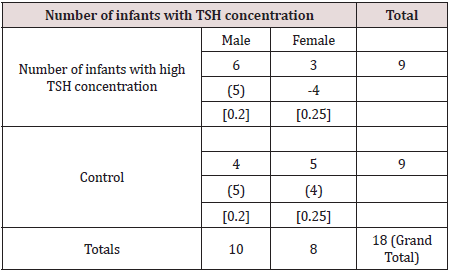
Lupine Publishers Group
Lupine Publishers
Menu
ISSN: 2644-1381
Research Article(ISSN: 2644-1381) 
Evaluation of TSH Concentration and Congenital Hypothyroidism in Infants of Pakistan Volume 2 - Issue 4
Muhammad Ameen*
- Department of Zoology and Biology Arid Agriculture University Rawalpindi, Pakistan
Received: April 24, 2020; Published: May 11, 2020
*Corresponding author: Muhammad Ameen, Department of Zoology and Biology, Arid Agriculture University Rawalpindi, Pakistan
DOI: 10.32474/CTBB.2020.02.000145
Abstract
Sub- clinical hypothyroidism (SCH) is the condition when the serum thyrotropin (TSH) level and normal serum thyroxine (T4) level has elevated. The most common congenital endocrine disorder is the congenital hypothyroidism (CH) which is considered major cause of mental retardation and body growth disorder. This retrospective study was performed on all 18 neonates, who were born during years 2014 and 2015. The infants with congenital hypothyroidism (CH) can be accurately diagnosed with laboratory tests performed at Nuclear Medicine, Oncology and Radiotherapy Institute (NORI) during the last five years. The data along with detailed history were collected with the help of clinicians in Nuclear Medicine, Oncology and Radiotherapy Institute (NORI) and entered in the Performa. TSH levels ranging from 0.27-4.2μIU/ ml was considered as normal for the diagnosis in thyroid function tests (TFTs). Thyroid scan, physical examination and ultrasound examination are the techniques that were used for evaluation of thyroid function tests (TFTs). These have evaluated through various statistical techniques in order to investigate thyroid dysfunctioning. The diagnostic evaluation relating to functional and morphological characterization has examined through serum TSH concentration and imaging. The results have determined non-significant difference between congenital hypothyroids and control infants. The study has concluded that the prevalence of congenital hypothyroidism is dependent on the higher concentration of thyroid stimulating hormone (TSH).
Introduction
Vissenberg et al., 2015 have described that Sub- clinical
hypothyroidism (SCH) is the condition when the serum thyrotropin
(TSH) level and normal serum thyroxine (T4) level has elevated.
Bain and Toublanc. 2002 have examined that the infants having
congenital hypothyroidism were undergone through diagnosis
for screening during early phase of treatment. [1] have described
that a thyroid disorder is physical ailment that arises from its
dysfunctioning that produces triiodothyronine (T3) and thyroxin
(T4). They have further observed that this dysfunctioning have
influenced functions of the pituitary gland and hypothalamus and
consequently their secretions.
Velkeniers et al., 2013 have investigated that improved embryo
implantation rate and live birth rate and a decreased miscarriage rate
with LT4 treatment, although no effects on the clinical pregnancy
rate were observed. They have systematically reviewed the abovelisted
RCTs and conducted a meta-analysis to determine whether
LT4 treatment attenuated adverse pregnancy outcomes in patients
with SCH or Levothyroxine treatment and pregnancy outcome
in women with subclinical hypothyroidism undergoing assisted
reproduction technologies: systematic review and meta-analysis
of RCTs. [2] have reported that the aforementioned disorder was
continuously increased in Iran from the ratio of 1:1400 to 1:1900
being statistically higher than the global average [3]. have observed
that a meta-analysis study about incidence of newborns’ congenital
hypothyroidism with the ratio of 2:1000 in Iran [4]. have reported
infants have diagnosed with congenital hypothyroidism through
screening programs and accordingly have applied the suitable
treatment with Levothyroxine alternative dosage administration
suppressing its adverse outcomes.
Materials and Methods
The appropriate study was carried out at Nuclear Medicine, Oncology and Radiotherapy Institute (NORI), Islamabad in infants of congenital hypothyroidism (CH) and normal control infants. The meta-analysis study has reported 9 congenital hypothyroid infants and 9 normal control infants [5]. The infants with congenital hypothyroidism were diagnosed through physical examination, clinical examination, Thyroid Scan, and Ultrasound reports. The infants having higher values of TSH were designated as congenital hypothyroid and were categorized into experimental group while, infants having normal values of thyroid functions tests (TFTs) were designated as normal and were placed into control group. Congenital hypothyroid infants were categorized according to the higher values of TSH levels. Hypothyroidism and hyperthyroidism can be accurately diagnosed with laboratory tests performed at NORI. The blood reports of thyroid function tests were collected from various laboratories of Pakistan and normal TSH concentration (0.27 to 4.2μIU/ml) was kept as criteria for the diagnosis of thyroid dysfunction.
Setting and study area
The appropriate study was carried out in Nuclear Medicine, Labs at NORI.
Study population
Total 18 infants that were referred for thyroid scan were included in the study.
Inclusion Criteria
All Congenital hypothyroid infants were included in the study.
Exclusion criteria
• Liver disease as evidenced by raised ALT level
• Drugs: Amiodarone, lithium, anti-thyroid medications
(neomercazole/procarbizole), thyroxin
Study Group
The whole population sample constituting the patients of congenital hypothyroid infants was based on the incidence of thyroid functions tests (TFTs).
Data Collection
After having informed consent (Annexure-I) from patients, the data along with detailed history was collected with the help of clinicians in NORI and entered in the Performa (Annexure-II).
Data Analysis
The data were analyzed using SPSS version 17. The average values for age, history of goiter (duration) etc. were calculated. The percentage of different thyroid dysfunctions (hypothyroid, hyperthyroid) in infants of congenital hypothyroidism was analyzed through confidence interval (0.05). Statistically defined P-value of the study is (0.000). The study has considered thyroid stimulating hormone (TSH) as a criterion for the diagnosis of thyroid dysfunction [6]. The normal range of thyroid function (TFTs) regarding TSH diagnosed at NORI hospital is (0.27-4.2μIU/ ml) and other clinical laboratories of Pakistan. The infants having high TSH concentration have been designated as Hypothyroid and the infants having low serum TSH concentration have been designated as hyperthyroid while the infants having normal TSH values are considered as euthyroid. The chi-square statistic is 0.9. The p-value is .342782. Not significant at p < .05. The statistical difference between congenital hypothyroid infants versus normal control infants have demonstrated in the above Table 1. The congenital hypothyroid infants have incorporated (50%) and control (euthyroid) have constituted (50%) of proportion in whole sample of population. When the lipid profile of euthyroids clinical and subclinical hypothyroid versus control group was compared, statistically non-significant difference was observed by non-parametric tests (p > 0.05). This shows that disease is most frequently reported in congenital hypothyroid infants as compared to normal (euthyroid). Similarly, the study is correlated with the findings of that incidence of newborns’ congenital hypothyroidism was observed with the ratio of 2:1000 in Iran. Similar results were observed in other relevant Studies. Therefore, abnormal TSH concentration has induced sub-clinical hypothyroidism in infants. The disease is frequently observed in infants with high TSH levels comparatively to normal TSH levels. The congenital hypothyroid have altered the lipid profile of control individuals. The recent study is according to the findings of Ladenson et al. have also considered that the TSH test as a criterion for the diagnosis of thyroid dysfunction, especially in cases of minimal thyroid failure (subclinical hypothyroidism), while such results are rejected in this new finding. The study has inconsistency with the findings of Evered et al. have been investigated that in case of mild hypothyroidism serum TSH also have been observed high and the values of T3 and T4 have remained in normal range, while in case of present study serum TSH levels fluctuates. However, thyroid dysfunctioning was prominent in patients experiencing congenital hypothyroidism.
Table 1: Χ2 Calculations (Two-way Contingency) showing statistical difference between congenital hypothyroid infants versus normal TSH concentration infants (control) of Goiter.

Conclusion
The appropriate research strategy has concluded that prevalence of congenital hypothyroidism is dependent on the extent of hormonal dysfunctioning specifically normal and abnormal TSH levels. In future comprehensive investigation is warrant covering the epidemiological profile of the patients having congenital hypothyroidism.
References
- Surks MI,HollowellJG (2007) Age-specific distribution of serum thyrotropin and antithyroid antibodies in the US population: implications for the prevalence of subclinical hypothyroidism. JClinEndocrinolMetab92(12):4575-4582.
- Ordookhani A, Minniran P,Najafi R, Hedayati M, AziziF (2003) Congenital hypothyroidism in Iran. Indian journal of pediatrics70:625-628.
- Veisani Y,Sayehmiri, K Rezaeian S, DelpishehA (2014) Congenital hypothyroidism screening program in iran; a systematic review and metaanalysis. Iranian journal of pediatrics24(6):665-672.
- MotamediN, Goodarzi E, Pordanjani SR, Valizadeh R, Moradi Y, et al. (2017)Incidence of phenylketonuria in Lorestan province, West of Iran (2006-2016). International Journal of PediatricsMashhad 5:4713-4721.
- Bain P, Toublanc JE(2002) Adult height in congenital hypothyroidism: prognostic factors and the importance of compliance with treatment. Hormone Research in Paediatrics58(3):136-142.
- Ladenson PW, Singer PA, Ain N Bagchi KB, BigosST (2000) American Thyroid Association guidelines for detection of thyroid dysfunction. Arch Intern Med 160(11):1573-1575.

Top Editors
-

Mark E Smith
Bio chemistry
University of Texas Medical Branch, USA -

Lawrence A Presley
Department of Criminal Justice
Liberty University, USA -

Thomas W Miller
Department of Psychiatry
University of Kentucky, USA -

Gjumrakch Aliev
Department of Medicine
Gally International Biomedical Research & Consulting LLC, USA -

Christopher Bryant
Department of Urbanisation and Agricultural
Montreal university, USA -

Robert William Frare
Oral & Maxillofacial Pathology
New York University, USA -

Rudolph Modesto Navari
Gastroenterology and Hepatology
University of Alabama, UK -

Andrew Hague
Department of Medicine
Universities of Bradford, UK -

George Gregory Buttigieg
Maltese College of Obstetrics and Gynaecology, Europe -

Chen-Hsiung Yeh
Oncology
Circulogene Theranostics, England -
.png)
Emilio Bucio-Carrillo
Radiation Chemistry
National University of Mexico, USA -
.jpg)
Casey J Grenier
Analytical Chemistry
Wentworth Institute of Technology, USA -
Hany Atalah
Minimally Invasive Surgery
Mercer University school of Medicine, USA -

Abu-Hussein Muhamad
Pediatric Dentistry
University of Athens , Greece

The annual scholar awards from Lupine Publishers honor a selected number Read More...




